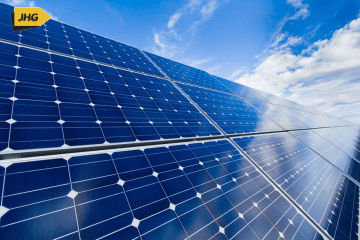The solar industry has come a long way in just the last few years. The latest developments and breakthroughs in solar technology include longer-lasting solar cells, solar cells that you can print onto flexible surfaces, solar panels that track the sun from east to west throughout the day, and solar power plants that work at night.
Solar Cell Efficiency
One of the most remarkable solar breakthroughs has been in solar cell efficiency. Solar technology system has achieved a 31.6% conversion rate from solar energy to electric current.
This is up from the previous 24.4%, making this an extraordinary development that could revolutionize solar power generation and lead to solar power being used in every household.
The solar industry is fast-moving, and solar power development requires constant updates on the latest scientific developments.
Despite solar cells being more efficient than ever before, solar energy still has not reached its full potential, so scientists are developing new ways to increase solar cell efficiency all the time.
Solar Windows
A solar window is a solar cell that acts as transparent glass, making solar energy generation less intrusive to the eye.
Solar windows are still in their research stage, but solar technology experts remain confident that solar windows will be available for purchase within the next five years or so.
The researcher behind these solar windows, Dr. Richard Lunt, has said solar windows are “almost like a solar cell one can install in a window.”
This is an increasing development in the solar market, as solar windows make solar cells more efficient because they use all types of light – not just visible light – to generate electricity.
This means that solar windows will have twice the energy production of solar cells since solar windows will generate electricity from the solar energy in the visible spectrum and solar energy from outside.
This is one of the latest developments and breakthroughs in solar technology
Solar-powered cars
Solar-powered cars are another technological development in solar power. A solar cell converts solar energy directly into electricity, powering a car’s motor.
Solar-to-fuel research by the Massachusetts Institute of Technology is another fascinating technology that uses solar energy to produce hydrogen fuel.
Interesting Scientific breakthroughs in Solar Energy
The solar industry has come a long way in just the last few years, driven by increased interest, investments, and research funding.
Night Time solar plant
In May 2016, solar power plant developers Enel Green Power North America unveiled a new solar power plant. It can produce electricity at night.
This solar farm is located in California’s Mojave Desert. It consists of a field of solar panels placed on steel stilts.
A battery system stores electricity from the solar farm during the day. Its then used to generate solar power at night.
Perovskite solar cells
In June 2016, researchers from Manchester University in England unveiled a new solar cell made from perovskite crystals.
To make a long story short, solar cells made from perovskite crystals can be as much as 20% more efficient than solar cells made from silicon. Perovskite solar cells have only been around since 2009, but they are quickly gaining traction.
Expect to see many more solar power plants and solar panels that use this technology in the coming years.
Sun-Tracking solar cells
In December 2016, researchers at the University of New South Wales unveiled solar cells that track the sun from east to west throughout the day.
These solar cells are shaped like bowls. They use solar trackers to follow the sun to capture more of its energy.
This solar cell comes from an array of smaller solar cells. Therefore it captures 40% more solar energy than a solar panel would. In fact, it can gather around 50% more solar power on a clear day.
Printable solar cells
In February 2017, researchers from Michigan Technological University unveiled solar cells that can be printed onto thin plastic sheets.
These solar cells measure only around half a millimeter thick. They are flexible enough to be rolled up.
They can also withstand being submerged in water or run over by a car without being damaged.
Solar cells that can be printed onto flexible sheets. They will enable solar power to be placed anywhere, including in places where solar panels cannot currently go.




